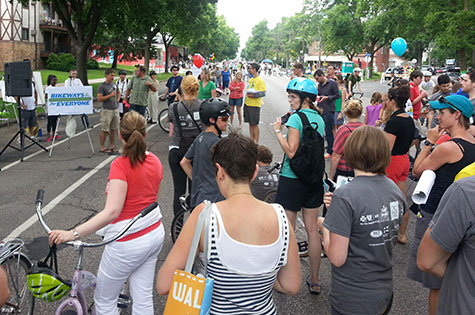
Open Streets initiatives temporarily close streets to automobile traffic so that people may use them for walking, bicycling, dancing, playing and socializing.
Although the movement is gaining popularity in the United States — more than 100 different cities have hosted Open Streets events since 2008 — little is known about planning and implementing them.
In a new paper, “Moving the Barricades to Physical Activity: A Qualitative Analysis of Open Streets Initiatives Across the United States,” Amy Eyler, PhD, and J. Aaron Hipp, PhD, both assistant professors at the Brown School at Washington University in St. Louis, explore the development and implementation of Open Streets initiatives and make recommendations for increasing the capacity of organizers to enhance their success.
“The benefit of Open Streets is that the events increase physical activity behavior and awareness of physical activity opportunities within the community,” Eyler said. “They are a big deal for both physical and social health of a city. Those benefits should outweigh the logistics concerns of potential organizers, but often do not since the outcomes may not be immediately apparent.”
Using a list of 47 events held in the United States in 2011, 27 lead organizers were interviewed by telephone about planning, implementation and lessons learned.
The most common reasons for initiation were to highlight or improve health and transportation. Most initiatives aimed to reach the general population, but some targeted families, children or specific neighborhoods. Getting people to understand the concept of Open Streets was an important challenge
Several initiatives have proven successful, despite limitations, said Hipp, who, along with Eyler, has developed a toolkit to help communities and organizers measure the positive impact of Open Streets.
“Ferguson Sunday Parkways here in St. Louis County is a very successful Open Streets event,” Hipp said. “This is their sixth year, with three to four events per year. The city, the YMCA and champions from each neighborhood meet year-round to ensure that each individual event is a success. The events attract 500-1,000 people living within several blocks of the route to play and engage with their neighbors.
“By moving around each time, Ferguson Sunday Parkways is able to target areas with limited access to parks and playgrounds and to bring in health-related activities to different communities.”
The next Ferguson Sunday Parkway event takes place Oct. 12. “After the events of this summer, I expect October’s Ferguson Sunday Parkways to be the most popular yet,” Hipp said. “Open Streets represent positive, democratization of public space, our streets, and I expect the citizens of Ferguson and the St. Louis region to really embrace this that day.”
Hipp sees more research measuring specific outcomes and attributing them to community intervention during the next several years, leading to increasing number of host cities and events.
“Amy and I were just invited to participate in the Open Streets Network of Champions, sponsored by the Robert Wood Johnson Foundation and 8-80 Cities, a Toronto-based nonprofit aimed at making cities livable for 8-year-olds and 80-year-olds,” Hipp said.
“I will be representing the two of us and our research team at the first meeting of Open Streets in Guadalajara, Mexico, later this month. This level of commitment to understanding what works and sharing across international cities shows there is continued and growing interest and that these initiatives will only gain in popularity over the next 5-10 years.”